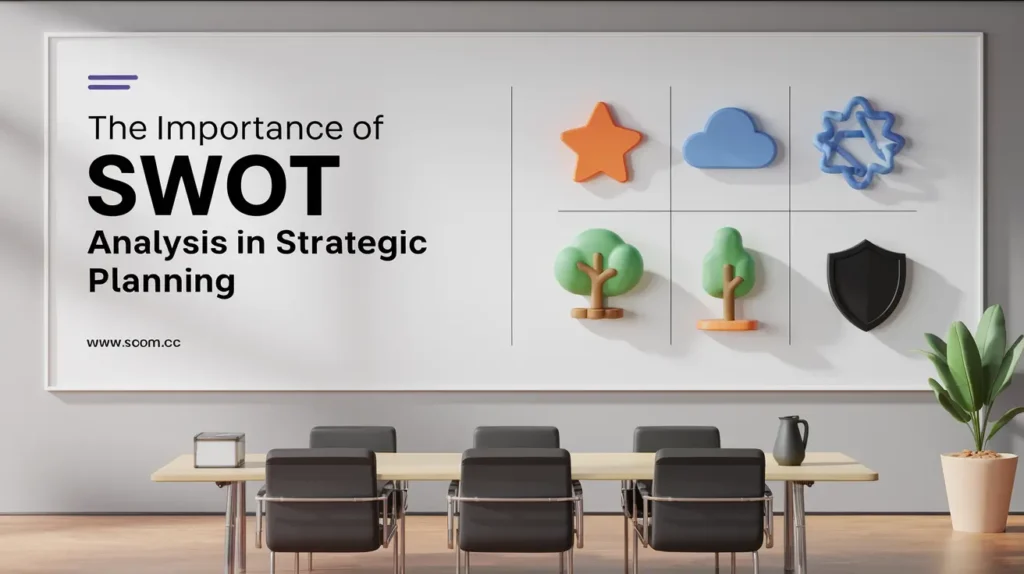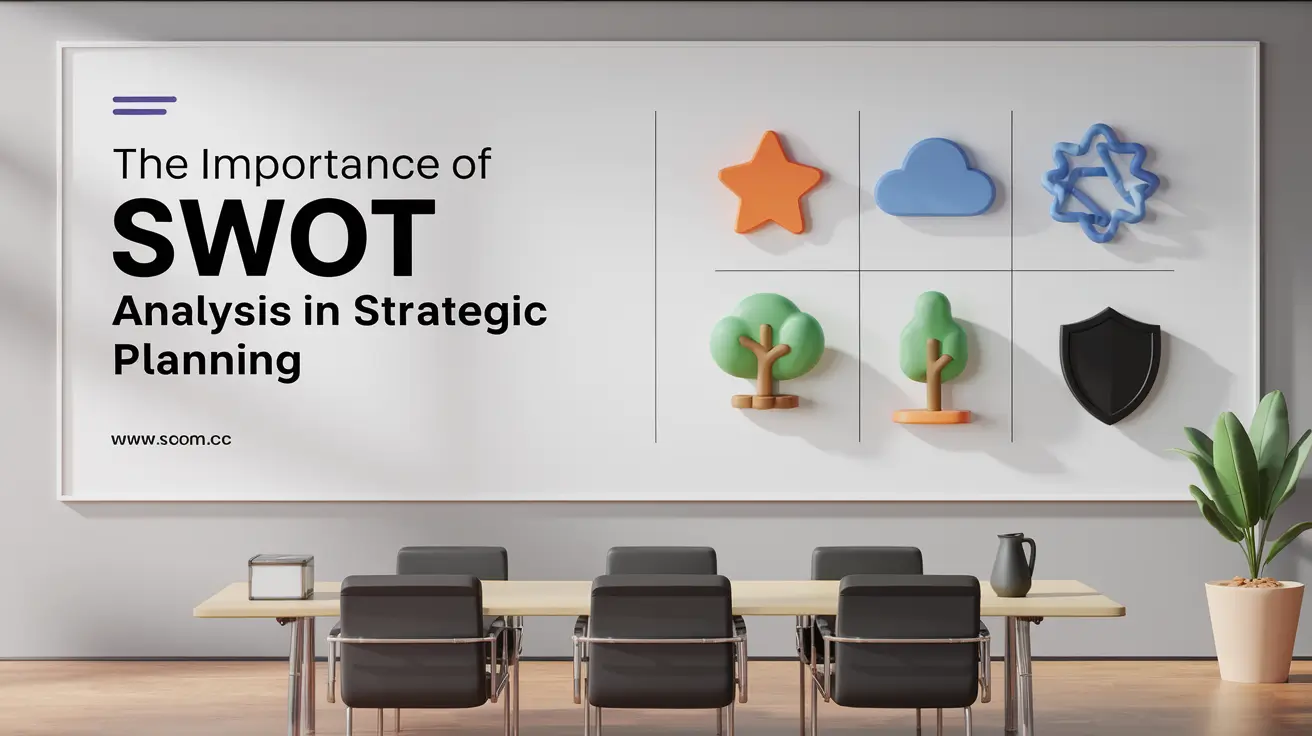The Importance of SWOT Analysis in Strategic Planning

- The Importance of SWOT Analysis in Strategic Planning
- 1. Understanding the SWOT Framework
- 2. Identifying Strengths: Leveraging What You Do Best
- 3. Recognizing Weaknesses: Addressing Internal Challenges
- 4. Exploring Opportunities: Capitalizing on Market Potential
- 5. Assessing Threats: Preparing for External Challenges
- 6. Integrating SWOT Analysis into Strategic Planning
- 7. Benefits of Using SWOT Analysis in Strategic Planning
- 8. Conclusion: The Power of SWOT in Strategic Planning
The Importance of SWOT Analysis in Strategic Planning
Strategic planning is essential for any business seeking long-term success. A key tool in this process is the SWOT analysis—a framework that helps organizations identify their Strengths, Weaknesses, Opportunities, and Threats. By conducting a thorough SWOT analysis, businesses can gain valuable insights that inform their strategic decisions and position themselves for growth in a competitive market. Below, we explore the importance of SWOT analysis in strategic planning and how to effectively utilize this powerful tool.
1. Understanding the SWOT Framework
The SWOT analysis is a simple yet effective framework that provides a comprehensive overview of an organization’s internal and external environments. By categorizing factors into Strengths, Weaknesses, Opportunities, and Threats, businesses can systematically evaluate their current position and future potential.
The Four Components of SWOT Analysis:
- Strengths: Internal attributes that give the business a competitive advantage.
- Weaknesses: Internal factors that hinder performance or growth.
- Opportunities: External factors that the business can capitalize on to achieve its goals.
- Threats: External challenges that could negatively impact the business.
This holistic view enables companies to make informed decisions about where to allocate resources and how to navigate both opportunities and risks.
2. Identifying Strengths: Leveraging What You Do Best
The Strengths component of SWOT analysis focuses on the internal factors that give your business a competitive edge. These could be tangible assets like strong brand recognition, proprietary technology, or a loyal customer base, as well as intangible qualities such as organizational culture or leadership expertise.
Examples of Strengths:
- Strong Brand Reputation: A well-established brand that is trusted by customers.
- Innovative Products: Unique products that differentiate your business from competitors.
- Skilled Workforce: A talented and experienced team that drives business success.
Recognizing your strengths allows you to build on them, ensuring that you continue to excel in areas where you already outperform the competition.
3. Recognizing Weaknesses: Addressing Internal Challenges
No business is without its weaknesses. The Weaknesses component of SWOT analysis helps you identify internal factors that may be limiting your success. This could include outdated technology, gaps in your product lineup, or insufficient financial resources. Acknowledging these weaknesses is the first step toward addressing them and improving your overall business performance.
Examples of Weaknesses:
- Limited Resources: A lack of funding or staffing that hampers growth initiatives.
- Inefficient Processes: Operational inefficiencies that increase costs or reduce productivity.
- Weak Online Presence: A subpar digital strategy that fails to engage customers effectively.
By confronting your weaknesses head-on, you can develop strategies to mitigate them and turn them into opportunities for improvement.
4. Exploring Opportunities: Capitalizing on Market Potential
Opportunities represent external factors that your business can exploit to achieve growth and competitive advantage. The Opportunities component of SWOT analysis encourages you to look beyond your current operations and identify trends, emerging markets, or new customer segments that could fuel expansion.
Examples of Opportunities:
- Market Expansion: Entering new geographical regions or demographic markets.
- Technological Advancements: Leveraging new technologies to enhance products or services.
- Strategic Partnerships: Forming alliances with other businesses to access new resources or customers.
By identifying and pursuing opportunities, your business can stay ahead of the competition and continue to evolve in a dynamic market.
5. Assessing Threats: Preparing for External Challenges
The Threats component of SWOT analysis focuses on external risks that could negatively impact your business. These could include economic downturns, increased competition, regulatory changes, or shifts in consumer behavior. Understanding potential threats allows you to develop contingency plans and mitigate risks before they become significant problems.
Examples of Threats:
- Competitive Pressure: New competitors entering the market with superior offerings.
- Economic Instability: Fluctuations in the economy that affect consumer spending.
- Regulatory Changes: New laws or regulations that impose additional costs or restrictions.
Proactively addressing threats can help your business remain resilient in the face of adversity and maintain its strategic focus.
6. Integrating SWOT Analysis into Strategic Planning
A SWOT analysis is most effective when it is integrated into the broader strategic planning process. By using the insights gained from SWOT, businesses can develop strategies that align with their strengths, address their weaknesses, seize opportunities, and mitigate threats. Here’s how to effectively incorporate SWOT analysis into your strategic planning:
Steps to Integrate SWOT Analysis:
- Align with Objectives: Ensure that the SWOT analysis aligns with your business’s long-term objectives and goals.
- Prioritize Actions: Focus on the most critical areas identified in the SWOT analysis—those that will have the biggest impact on your strategic success.
- Develop Strategies: Create actionable strategies that leverage your strengths and opportunities while addressing weaknesses and threats.
- Monitor Progress: Continuously monitor the implementation of your strategies and adjust them as needed based on changing circumstances.
By integrating SWOT analysis into your strategic planning process, you can create a roadmap that guides your business towards sustained growth and success.
7. Benefits of Using SWOT Analysis in Strategic Planning
The benefits of incorporating SWOT analysis into your strategic planning are numerous. This tool provides a structured approach to decision-making, enhances your understanding of your business environment, and helps prioritize actions that will drive success. Some key benefits include:
Key Benefits of SWOT Analysis:
- Enhanced Clarity: Provides a clear understanding of where your business stands in the market.
- Informed Decision-Making: Supports data-driven decisions by providing a comprehensive view of internal and external factors.
- Strategic Focus: Helps prioritize initiatives that are most aligned with your business goals.
- Risk Management: Identifies potential threats early, allowing you to develop strategies to mitigate them.
Ultimately, SWOT analysis serves as a valuable tool for aligning your business’s strengths with market opportunities while safeguarding against risks.
8. Conclusion: The Power of SWOT in Strategic Planning
Incorporating SWOT analysis into your strategic planning process is essential for any business aiming for long-term success. This framework provides a comprehensive view of your business’s internal and external environments, enabling you to make informed decisions that drive growth and resilience. By understanding your strengths, addressing your weaknesses, capitalizing on opportunities, and preparing for threats, you can develop strategies that position your business for sustained success in an ever-evolving marketplace.

If you enjoyed this article and found it valuable, we encourage you to explore our news and valuable information section, where you'll find more relevant and up-to-date content that may pique your interest. Additionally, if you are seeking advice or need guidance on a specific topic, we suggest visiting our services section. There, you will find a variety of options designed to assist and support you in addressing your needs. Feel free to check out both sections to get the information and assistance that best suits your requirements.

Leave a Reply